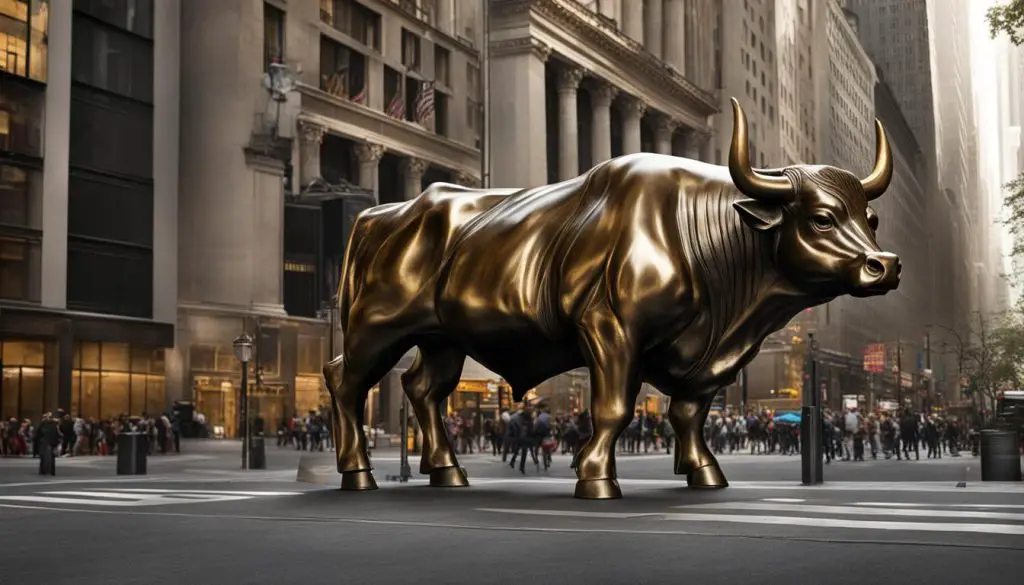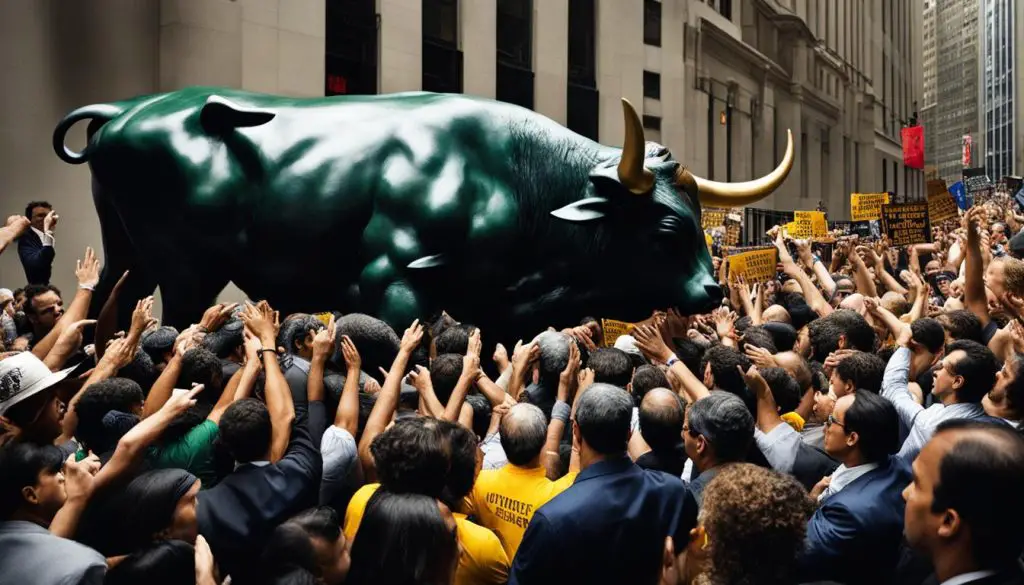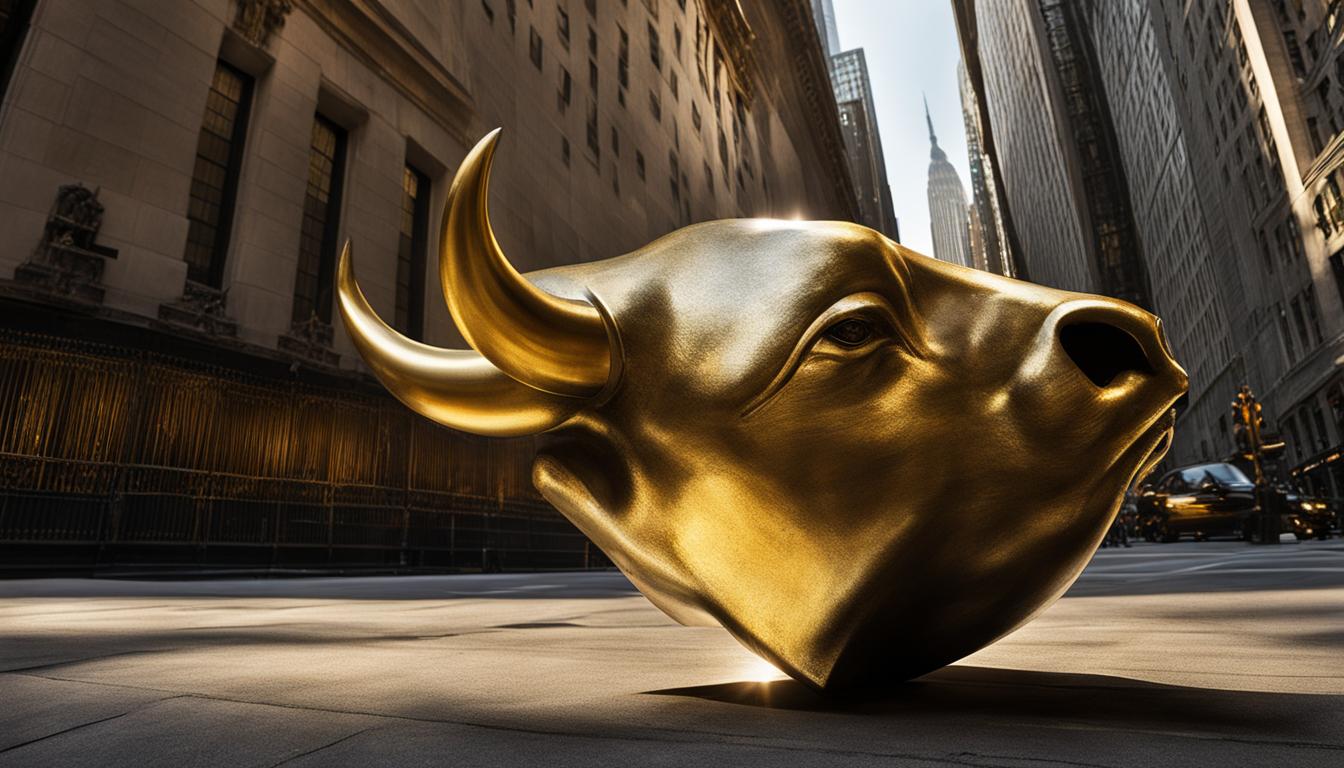Have you ever wondered if there’s a secret to gaining good luck on Wall Street? One popular tradition among visitors to New York City is touching the Wall Street Charging Bull for good luck. But should you touch the bull’s horn or ball? Is there really a charm to this iconic statue? Let’s explore the fascinating world of the Wall Street Bull and its connection to good fortune.
The Wall Street Charging Bull has become a symbol of financial power and prosperity since its guerrilla art installation in 1989. Tourists from all over the world are drawn to this magnificent bronze sculpture, believing that rubbing either the bull’s horn or ball will bring them luck. While some believe that fondling the bull’s testicles is the key to prosperity, others think that touching the horn is the way to go. So, should you rub the bull’s ball or touch its horn for good luck? Let’s find out.
Contents
- 1 The History and Symbolism of the Wall Street Charging Bull
- 2 The Wall Street Bull’s Cultural Impact and Global Recognition
- 3 The Tradition of Touching the Wall Street Bull for Good Luck
- 4 The Wall Street Bull as a Symbol of Financial Power
- 5 The Wall Street Bull’s Controversies and Criticisms
- 6 Conclusion
- 7 FAQ
- 7.1 Should I touch the Wall Street Charging Bull’s horn or ball for good luck?
- 7.2 What is the history and symbolism of the Wall Street Charging Bull?
- 7.3 What is the cultural impact and global recognition of the Wall Street Bull?
- 7.4 Why do people touch the Wall Street Bull for good luck?
- 7.5 What does the Wall Street Bull represent?
- 7.6 What are the unique features and design of the Wall Street Bull?
- 7.7 What controversies and criticisms surround the Wall Street Bull?
- 7.8 Is touching the Wall Street Bull really a good luck charm?
- 8 Source Links
Key Takeaways:
- Touching the Wall Street Charging Bull is a popular tradition believed to bring good luck.
- Visitors can choose to touch either the bull’s horn or ball for their desired fortune.
- The bull has become an iconic symbol of financial power and prosperity on Wall Street.
- The tradition of rubbing the bull’s testicles may have originated from various cultural beliefs.
- The decision to touch the bull for good luck is ultimately up to you.
The History and Symbolism of the Wall Street Charging Bull
The Wall Street Charging Bull, also known as the Bowling Green Bull, has a fascinating history and powerful symbolism. Created by Italian artist Arturo Di Modica, the bull was crafted as a response to the 1987 stock market crash. Di Modica intended the statue to represent America’s power and resilience, capturing the spirit of Wall Street. In 1989, he installed the sculpture without permission near the New York Stock Exchange, which led to its impoundment by the police. However, due to public outcry, the statue was eventually relocated to Bowling Green, where it stands today.
The Wall Street Bull has become more than just a sculpture. It has become a symbol of financial optimism and prosperity. The bull’s charging stance and muscular form convey energy, determination, and the strength to overcome challenges. As visitors flock to see the iconic statue, they are reminded of Wall Street’s enduring power and the belief that with hard work and determination, one can achieve success in the financial world.
With its rich history and powerful symbolism, the Wall Street Charging Bull continues to inspire and captivate people from all walks of life. It represents the indomitable spirit of America and its unwavering belief in the potential for financial success. The next time you visit New York City, make sure to take a moment to appreciate the history and symbolism behind this iconic statue.
The Origins of the Wall Street Bull
“The bull represents the strength and determination needed to succeed in the financial world. It’s a symbol of the American dream and the power of capitalism.” – Arturo Di Modica
| Year | Event |
|---|---|
| 1987 | The stock market crash shakes the financial world. |
| 1989 | Arturo Di Modica installs the Charging Bull near the New York Stock Exchange without permission. |
| 1989-1990 | The bull is impounded by the police but eventually relocated to Bowling Green due to public outcry. |
- The Wall Street Charging Bull was created by Italian artist Arturo Di Modica.
- It was installed near the New York Stock Exchange without permission in 1989.
- After being impounded by the police, the bull was relocated to Bowling Green.
- Today, it symbolizes financial power and resilience.
The Wall Street Bull’s Cultural Impact and Global Recognition
The Wall Street Bull, with its iconic presence and symbolism, has left a lasting cultural impact and gained global recognition. Its powerful image has been featured in various movies and TV shows, solidifying its status as a symbol of financial power and prosperity.
One such movie is “The Wolf of Wall Street,” where the bull appears as a backdrop to many scenes, representing the wild and ambitious world of finance. In the romantic comedy “Hitch,” the bull serves as a meeting spot for the main characters, emphasizing its significance as a recognizable landmark.
Furthermore, the fame of the Charging Bull extends beyond New York City. Replicas of the statue can be found in other cities around the world, such as Shanghai and Amsterdam. These replicas attract tourists and locals alike, highlighting the universal recognition and appeal of this iconic symbol.
| Movies and TV Shows featuring the Wall Street Bull |
|---|
| “The Wolf of Wall Street” |
| “Hitch” |
The Wall Street Bull’s Global Replicas
The popularity of the Charging Bull has inspired the creation of replicas in various cities, allowing people from different parts of the world to experience its symbolism and cultural significance. Some notable replicas include:
- Shanghai: The Bund Bull in Shanghai, China, stands as a symbol of financial growth and development in the country.
- Amsterdam: The Bronze Bull in Amsterdam, Netherlands, represents the city’s thriving financial sector and serves as a popular tourist attraction.
“The Charging Bull has become a symbol of financial power and prosperity, featured prominently in movies and replicated worldwide. Its cultural impact is undeniable, appealing to people from all walks of life.” – Financial Film Magazine
The Wall Street Bull’s cultural impact and global recognition are testaments to its enduring appeal and significance. Whether it’s starring in movies, attracting tourists, or inspiring replicas, this iconic symbol continues to captivate audiences worldwide.
The Tradition of Touching the Wall Street Bull for Good Luck
One of the main attractions of the Wall Street Charging Bull is the tradition of touching the statue for good luck. Visitors rub either the bull’s horn or ball, believing that it will bring them prosperity and fortune. The tradition of touching the bull’s genitalia may have originated from a combination of cultural beliefs and the universal fascination with money and genitals. The bull’s brass balls have been rubbed so frequently that they have become burnished and gleaming, a testament to the popularity of this tradition.
This unique custom has garnered interest from tourists, who flock to the bull to experience this superstitious ritual. Whether it is done out of a genuine belief in its luck-bringing properties or simply for the novelty of the act, touching the Wall Street Bull has become an integral part of the overall experience of visiting New York City.
Some argue that the tradition of touching the bull for luck adds to the charm and allure of the iconic statue, further cementing its status as a symbol of financial power and prosperity. The act of physically interacting with the bull connects visitors to the spirit of Wall Street, creating a sense of participation in the financial world. It also serves as a reminder of the importance of luck and fortune in the pursuit of success.
The Wall Street Bull as a Symbol of Financial Power
The Wall Street Charging Bull has come to symbolize financial power and prosperity on Wall Street. Its presence in the Financial District of New York City serves as a constant reminder of the strength and resilience of the stock market. The bull’s imposing figure and powerful stance embody the confidence and optimism associated with the world of finance.
For many, the Charging Bull is seen as a symbol of prosperity, representing the potential for wealth and success in the financial industry. Its size and muscular physique evoke a sense of strength and determination, reflecting the tenacity required to navigate the complexities of the stock market. Visitors from around the world view the bull as a testament to the economic prowess of the United States and the opportunities available in the financial sector.
The Wall Street Bull’s presence also serves as a source of inspiration to those who aspire to achieve financial success. It serves as a reminder that with hard work, dedication, and strategic decision-making, anyone can overcome obstacles and achieve their goals in the realm of finance. The bull’s symbolism extends beyond Wall Street, resonating with individuals and businesses alike, encouraging them to strive for financial growth and stability.

Table: Wall Street Bull’s Unique Features
| Feature | Description |
|---|---|
| Height | 11 feet |
| Weight | 7,100 pounds |
| Position | Lowered head and twisted body |
| Surface | Gleaming bronze |
| Features | Imposing horns, flared nostrils, curved tail |
The Wall Street Charging Bull’s unique design and features make it an iconic sculpture that embodies financial power and resilience.
The Wall Street Bull’s Controversies and Criticisms
The Wall Street Bull, despite its popularity as a symbol of prosperity and financial power, has also faced its fair share of controversies and criticisms. Some view the statue as a representation of capitalism and question its presence in the heart of the Financial District. During the Occupy Wall Street protests in 2011, the bull became a focal point of criticism against the financial industry, seen by many as a symbol of inequality and corporate greed.
Furthermore, the bull has been compared to the biblical golden calf, a figure of idolatry and worship. This association has led to interpretations of the Charging Bull as an emblem of excessive materialism and misplaced priorities. Critics argue that the statue reinforces a system that prioritizes profit over people, disregarding the needs of the working class.
However, it is important to note that the Wall Street Bull’s significance and interpretation may vary depending on one’s perspective. While some see it as a celebration of capitalism and financial success, others view it as a reminder of the inequalities and flaws within the financial system. The bull’s presence and its controversies contribute to ongoing discussions about wealth distribution and the role of Wall Street in society.
Public Opinion on the Wall Street Bull
“The Charging Bull represents the very essence of Wall Street and the American Dream, with its triumphant spirit and unwavering determination.” – Financial Analyst
“The bull is a symbol of the divide between the rich and the poor, a stark reminder of the wealth gap in our society.” – Social Activist
Wall Street Bull as an Anti-Capitalist Symbol
Interestingly, while the Wall Street Bull has become synonymous with capitalism and financial prosperity, it has also been embraced by some as an anti-capitalist symbol. The bull’s unauthorized installation by artist Arturo Di Modica in 1989 challenged the established norms and institutions of Wall Street. Its unexpected presence and subsequent relocation to Bowling Green in the face of public support showcased the power of art and dissent.
Those who interpret the Charging Bull as an anti-capitalist symbol argue that it serves as a reminder of the inherent contradictions and injustices within the financial system. By subverting the intended meaning of the bull as a celebration of capitalism, they see it as an emblem of resistance against corporate greed and wealth inequality.

| Controversies | Criticisms |
|---|---|
| The bull seen as a symbol of capitalism and inequality | Presence of the bull in Financial District questioned |
| Comparison to the biblical golden calf and idolatry | Viewed as emblem of excessive materialism |
| Occupy Wall Street protests targeted the bull as a representation of corporate greed | Critics argue the bull prioritizes profit over people |
Conclusion
The tradition of touching the Wall Street Charging Bull’s horn or ball for good luck has become a unique aspect of visiting New York City. Whether you believe in its power to bring fortune or simply see it as a lighthearted photo opportunity, the bull’s symbolism of financial power and prosperity has captured the imagination of visitors from all over the world.
With its massive bronze presence and distinctive features, the Wall Street Bull stands as a testament to the strength and determination associated with the financial industry. Whether you choose to touch its horn or ball, the act adds a memorable twist to your New York City experience and leaves you feeling connected to the history and spirit of Wall Street.
So, should you touch the Wall Street Charging Bull for good luck? The decision is ultimately yours. But one thing is for sure – the bull’s allure as a good luck charm and iconic landmark continues to attract tourists and locals alike. Whether you’re seeking fortune or simply want a unique photo opportunity, don’t pass up the chance to engage with this symbol of financial power and prosperity.
FAQ
Should I touch the Wall Street Charging Bull’s horn or ball for good luck?
The decision is ultimately up to you, but many visitors believe that touching either the bull’s horn or ball brings them good luck.
What is the history and symbolism of the Wall Street Charging Bull?
The bull was created as a response to the 1987 stock market crash and symbolizes America’s power and resilience. It was installed without permission near the New York Stock Exchange in 1989 and has since become a symbol of financial power and prosperity on Wall Street.
What is the cultural impact and global recognition of the Wall Street Bull?
The bull has appeared in movies and TV shows and has replicas in other cities around the world. It is a popular tourist attraction and an iconic landmark in New York City.
Why do people touch the Wall Street Bull for good luck?
Visitors believe that touching the bull’s horn or ball will bring them prosperity and fortune.
What does the Wall Street Bull represent?
The bull represents financial power and prosperity on Wall Street. It symbolizes the strength of the stock market and the can-do spirit of America.
What are the unique features and design of the Wall Street Bull?
The bull is a massive bronze sculpture standing 11 feet tall and weighing 7,100 pounds. It captures the energy and power of a charging bull with its muscular body and distinctive features such as the horns, flared nostrils, and curved tail.
What controversies and criticisms surround the Wall Street Bull?
Some view the bull as a symbol of capitalism and criticize its presence in the Financial District. It has also been likened to the biblical golden calf. However, its popularity among tourists and status as a New York City landmark cannot be denied.
Is touching the Wall Street Bull really a good luck charm?
The tradition of touching the bull for good luck is a unique aspect of visiting New York City. Whether it brings fortune or serves as a lighthearted photo opportunity, it adds a memorable twist to your experience.





